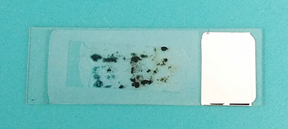Wisconsin Occupational Health Laboratory (WOHL) Advanced Microbiologist Terri Williams facilitated the development of a new ASTM International test method that will help laboratories identify mold from tape lift samples. Tape lift samples are sometimes used as part of occupational health and air quality investigations. The method was developed by ASTM International’s committee on air quality.

A tape lift sample with mold is adhered to a glass slide so it can be examined under a microscope.
According to the ASTM International news release – “The new tape lift sample test method includes how to prepare a sample for observation under direct-light microscopy. It also outlines the equipment needed and provides step-by-step instructions to perform the analysis. Finally, the standard states what a lab should report to its customer, at a minimum.”
Williams, a member of ASTM committee D22 Air Quality and the subcommittee D22.08 on Mold Sampling and Analysis, volunteered to be a technical contact for this method. Since ASTM International uses a voluntary consensus process, Williams facilitated discussions and recorded edits to the method in progress at each ASTM meeting she attended. The process can take many revisions over years.
“After each vote cycle, I would reach out to members who voted negative and discuss their views in addition to other comments recorded in the voting process,” Williams explains. “Any comments or discussion I had individually with the member, I would take back to the committee for edits in addition to those comments already on record and we would them incorporate if they were found persuasive. The cycle would perpetuate until there were no persuasive negative votes and all comments were addressed.”
ASTM International is a globally recognized leader in the development and delivery of voluntary consensus standards. Today, over 12,000 ASTM standards are used around the world to improve product quality, enhance health and safety, strengthen market access and trade, and build consumer confidence.
